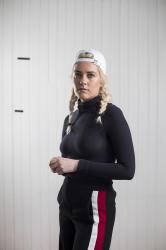Pharology: the scientific study of lighthouses.
It’s a rather archaic term, for as radar and other navigation tools took over the guidance of ships, those who specialised in the use and upkeep of lighthouses became fewer and fewer. Nowadays, the term ‘pharologist’ is used mainly by aficionados fascinated by the niche buildings—many of which now stand empty or repurposed.
Quartet Amiina can be counted among their ranks. Enamoured of the historical buildings’ utilitarian uses and romanticism, the quartet is back with the new EP ‘Pharology’, an expansive, escapist effort that walks the line between experimental, ambient, subversive neo-classical and prelude to the impossible—an EP that’s as varied as the ocean by which it was written.
Saving souls
‘Pharology’ is actually Amiina’s second lighthouse-inspired effort, following 2013’s ‘The Lighthouse Project’, which saw the band journey across Iceland to perform at various lighthouses and other unusual locales.
“Travelling in Iceland, you see these lighthouses in barren places and that’s in a sense very poetic and grabbing as an image. But the purpose of the lighthouse is always to get light out there even though no one is looking. It might actually be saving someone,” founding Amiina member María Huld Markan Sigfúsdóttir explains. “Someone close to us came up with the metaphor that artists are our own kind of lighthouses. We pour out [our art] and just hope that someone is listening.”
She smiles. “It’s maybe not as dramatic as saving souls.”



Musical aids to navigation
The direct origins of ‘Pharology’, though, come from a commission Amiina received in 2019 for a sound installation at the Nakkehoved lighthouse in Denmark. Inspired by the pitches created by the rotation of the cone at the top of the lighthouse, the group made a harmonic series that changed over each meandering level of the building. This series eventually coalesced into the new EP.
Along with falling back in love with the remote romanticism of lighthouses, the Danish installation also found the group fascinated with its compatriots in guidance, morse code. In fact, ‘Pharology’ begins with a beat that is the actual morse code for Nakkehoved.
“Morse codes were a creative spark for us,” María Huld continues. Bandmate Guðmundur Vignir Karlsson nods. “We played around and found a morse code that works as a rhythmic ostinato through the song, which is the name of the lighthouse,” he explains.
The song in question—“Aton”—opens the album with a rumbling, tribal beat that almost feels made for a modern dance piece. It’s a piece that buries deep into the primitive part of your soul—a beautiful illustration of the divinity of fight or flight. “When we got home, we saw that the music was like a journey. ‘Aton’ is quite aggressive and has a raw feeling of danger,” María Huld says.
“It’s like a storm. Aton—aid to navigation,” Vignir adds.
From there, the journey continues into the world of the stilled sea. “‘Refraction’, which is next, is the bending of the light inside the glass, a serenic pause of space. Then ‘Beacon’, the last song, is the tower and the guidance,” María Huld concludes.

Photo by Art Bicnick
Amiina returns to a safe harbour
The album is truly an affecting one. It’s not easy listening, filled at all times with a sense of longing and unrelenting solitude. It’s the music of a rugged lighthouse keeper—one who has retreated from society in unfaltering service of its safety.
And for Amiina, it was both a celebration of the lighthouse as a symbol and also a tribute to the institution as a lost art form and branch of science.
“It was fascinating to go through the [history of the] different signals, how the projecting of the light has changed from being just fire into the single cones of glass. Also, how through time, the rotation and mechanism of the signal has evolved,” María Huld explains. “And especially in Iceland, how important these places were and are for navigating.”
“The only points of reference to a safe harbour,” Vignir concludes.
Pick up your copy of ‘Pharology’ by Amiina here.
Note: Due to the effect the Coronavirus is having on tourism in Iceland, it’s become increasingly difficult for the Grapevine to survive. If you enjoy our content and want to help the Grapevine’s journalists do things like eat and pay rent, please consider joining our High Five Club.
You can also check out our shop, loaded with books, apparel and other cool merch, that you can buy and have delivered right to your door.
Also you can get regular news from Iceland—including the latest notifications on eruptions, as soon as they happen—by signing up to our newsletter.
Buy subscriptions, t-shirts and more from our shop right here!
















